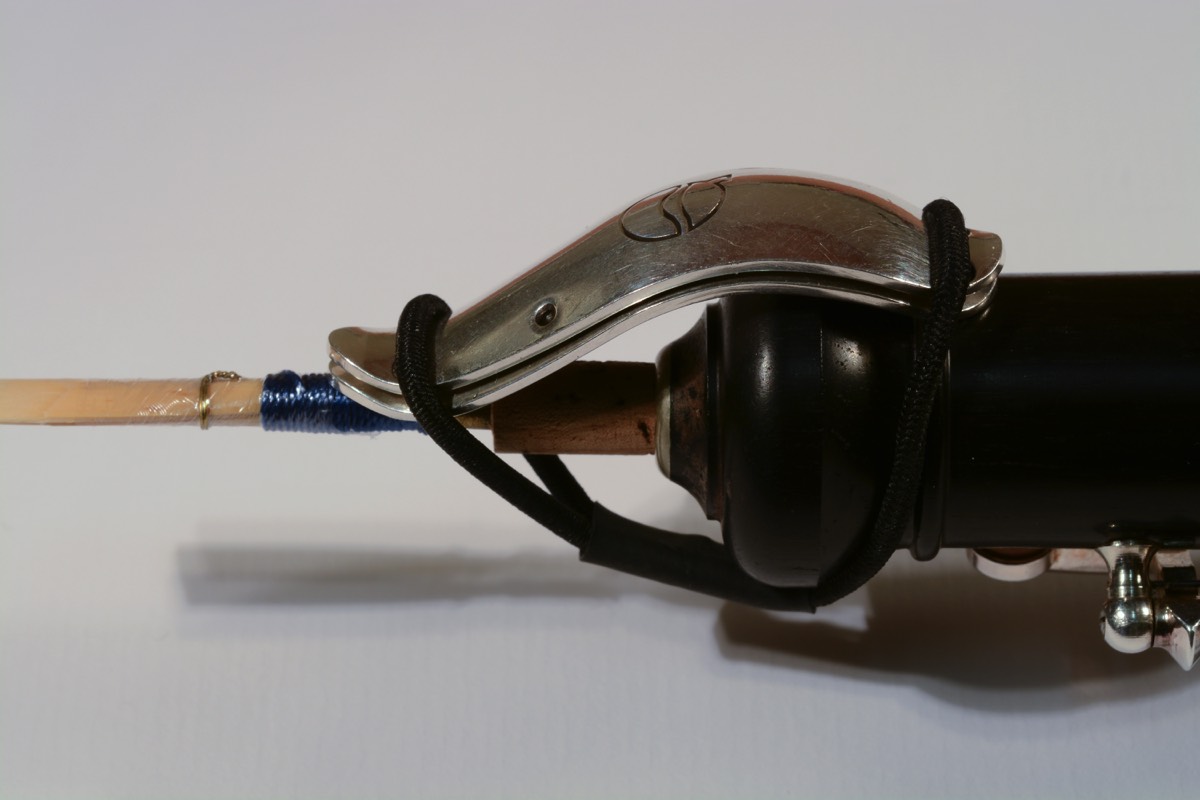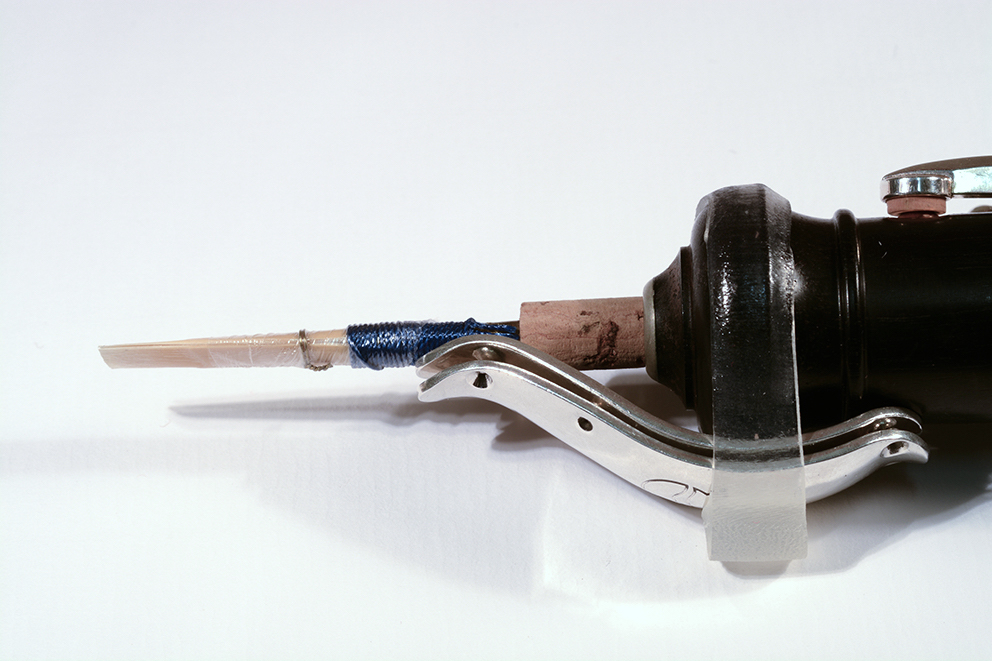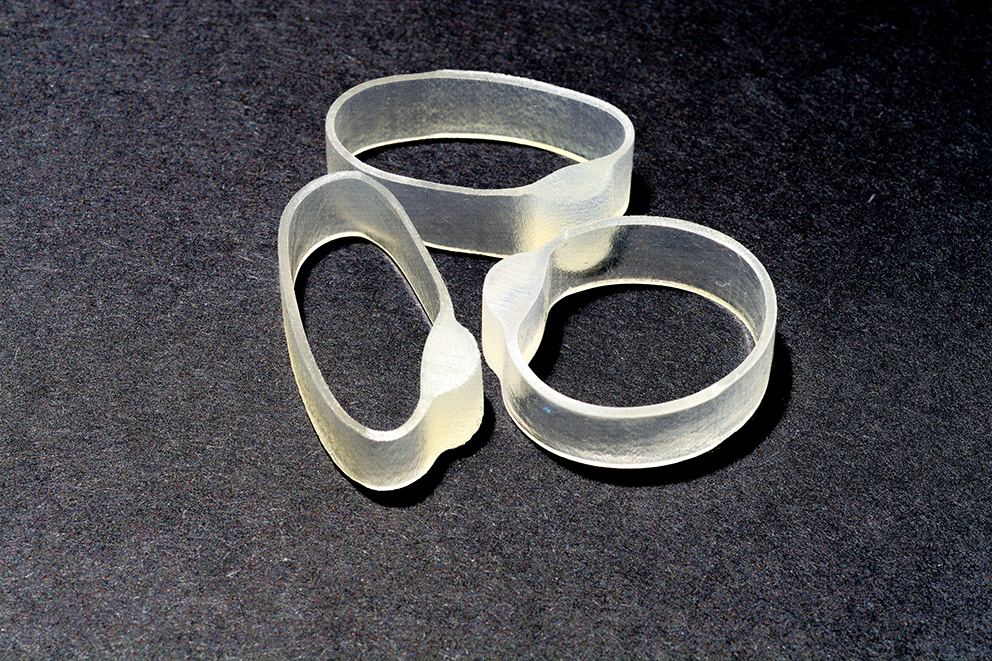
Solid Silver Bridge with rubber bands
The LefreQue Sound Bridge
Some Background
I first encountered the Lefreque Sound Bridge when the system for oboe arrived through the post. I had been approached to trial and review the Sound Bridge and the distributor in the UK, Wood ,Wind and Reed of Cambridge sent me a set.
Before trying the system on my oboe I carried out some online research and was met by sceptiscm and approval in roughly equal measure. Words such as “snake oil,” “smoke and mirrors,” “voodoo,” “no scientific principles,” “can’t possibly work”, “waste of money,” “some people will believe anything,” “homeopathy for wind instruments,” and so on. Other bloggers had written approving words but couldn’t describe why they felt the way they did. Playing felt easier or the sound was fuller, or the intonation was better but there was always an element of uncertainty. But from my perspective and this is a very important ‘but’ I had happened to notice that one of my favorite flute players Alison Mitchell principal flautist for the Scottish Chamber Orchestra, was using a metal link between the head joint and the body of her flute. This metal link I now know is the LefreQue Sound Bridge.
I got in touch with Alison and arranged to meet her and have a playing demonstration of the system. Without any doubt at all there is a big difference in the quality of the sound produced. We were in quite a small room and differences in quality might be harder to recognize but the change was marked. The tonal quality is slightly brighter with more energy in the mix. Alison and I chatted about these differences and she remarked that it is far more marked than just a change of lip plate or head joint. She also feels that the dynamic range is easier to control at the extremes; attack and release of notes is just better with a degree more in flexibility. Concerto playing is much less taxing, as the projection is better so that you as player don’t feel quite so submerged by the orchestra. She plays on a Murumatsu flute and feels she needs this extra sonic boost in a concerto situation, as the Powell is intrinsically rather mellow. So a big thumbs up here. Another devotee is Emily Beynon principal flautist of the Royal Concertgebouw Orchestra.
What is it?
A combination of two small metal plates is firmly attached by silicone bands between the joints of the instrument. The metals used range from red brass through to gold plated solid silver. This immediately creates a suspicion that the more you pay for the top of the range the better the result. Hence a doubt creeps into the mind and we are back to “snake oil” theories! One of the plates is smooth on the surface that abuts the instrument and the bands make contact with the upper plate that has six mini spikes in contact. These spikes help to isolate the damping effect of the silicone band. This allows the lower plate to vibrate almost completely freely and transport the high frequencies to the next part of the instrument. The spike system is similar to those on Hi-Fi loudspeaker cabinets, which isolate them from the floor. The publicity material from the designer Dutch saxophonist Hans Kuijt describes in some detail some of the natural science behind the design. I suggest you read for this yourselves and make your own minds up about these theories. Their website is: www.lefreque.com Email: info@lefreque.nl
A physical principle that I can understand is that the best instrument design would be that of a single tube like a Didgeridoo! I can also understand that tightly coupling tubes to minimize the joint problem caused by linings - of cork for example - might interrupt the free passage of vibrations between joints. So I can readily understand that metal instruments such as the flute, saxophones, and brass family could benefit as the actual tube lends a certain amount of vibration to the tone quality. With a wooden instrument though, that has a denser and less flexible physical property, a sense of the vibration within it seems more difficult to grasp. Simply put (!), a combination of the vibrations of the reed, the length and shape of the bore, the position, length, undercut and shape of tone holes create the sound quality. The mixture of the fundamental frequency, its harmonics and their distribution gives each instrument its individual tonal envelope that is its quality and timbre.
On the oboe
So it was with a smidgeon of doubt that I opened the packet of bits and pieces. There were two sets of plates for me to try. One in silver-plated brass and one made from solid silver. There was also a wide selection of silicone bands in various sizes. The instructions for the oboe emphasised that connecting the top joint of the oboe with the reed would produce the most benefit from a Sound Bridge. The band was rather difficult to apply and as it must be tight around the turned top of the joint introducing the plates underneath was not an easy task. The reed is placed in the oboe with the free end of the plate pressing firmly on the lower part of the thread binding. The process is not quick and I feared for the rapid accidental death of the reed as the plate, or my fingers hit the scraped cane and demolished it. Subsequently a modified elasticated binding has been produced that is easier to manage. This takes the form of a double loop and is a significant improvement over the silicone original. I hope that the photographs clearly show these differences.
To the Point – did it work?
The answer to that question has to be a little inconclusive. The first time I used the plates I was utterly convinced that there was a big difference in the smoothness with the change of register over the break. For instance C-to-C sharp chromatically up and down was just so much more fluent and secure without being extra careful – particularly when playing slowly and quietly. The instrument did feel more alive and responsive and there was an uncanny change to some of the “problem” notes. Intonation seemed to be better, for example bringing down the pitch of the first octave G and E. Also F sharps were good and the top C sharp lower in pitch. I could also taper off notes with more security. Well actually it was like having a really great reed!
My first experience had been using a Marigaux 901 but I have other oboes and having tried them and I came to a conclusion that the heavier walled instruments such as Howarth XL or Loree Royal did not demonstrate the same sudden upsurge of improvement as the lighter Rigoutat Evolution and the Marigaux 901. So maybe the theories of the “science” have some truth in them. Next, I tried a 1950s Howarth S2 that is extremely light and thin-walled and was surprised that the sound became wild and coarse! So there is a change in the sound. The plates do something to affect that. Strangely, the solid silver was less aggressive than the silver-plated brass. Can’t think why, but it did. So the material does have an effect.
Unfortunately I couldn’t emulate these changes with the next reed I tried. I experimented with the different oboes but there was still no evidence of change. The sound, the feel, the security, the scale were unaffected! I next tried different reeds with different staples and found perhaps a reason for these diverse results. Firmer staples such as those covered in plastic or the solid metal type were less affected than the softer cork or cork substitutes. Reeds made on these staples seemed to demonstrate a more noticeable change than those made on the more solid staples. So am I saying that using softer staple covering and the plates is a better combination than the solid staple alone? Only time will tell I’m sorry to say.
Conclusions
There is a modification to the sound but the material covering the staple makes some difference to the effectiveness of the plates. The absolute key though seems to be finding the “sweet spot” for the ends of the plates and how they impact on both the top joint and the reed. The improved black version of the attaching bands is better than the white silicone variety but does not grasp the plates with the same degree of security. This is why I think I wrestled in my attempts to emulate my first “shining light “ encounter. It would be for you the player to try out the LefreQue Sound Bridge in a practical situation. You may find as I did a Damascus Road experience with my first attempt and never play the oboe again without them. Or you may just decide to find that great reed or that great new oboe. On balance though I recommend that you give them a try. You may find that you have the best reed of your life and the best oboe when you do!
Geoffrey Bridge

Solid silver plates mounted using silicone rubber bands

Silcone rubber bands